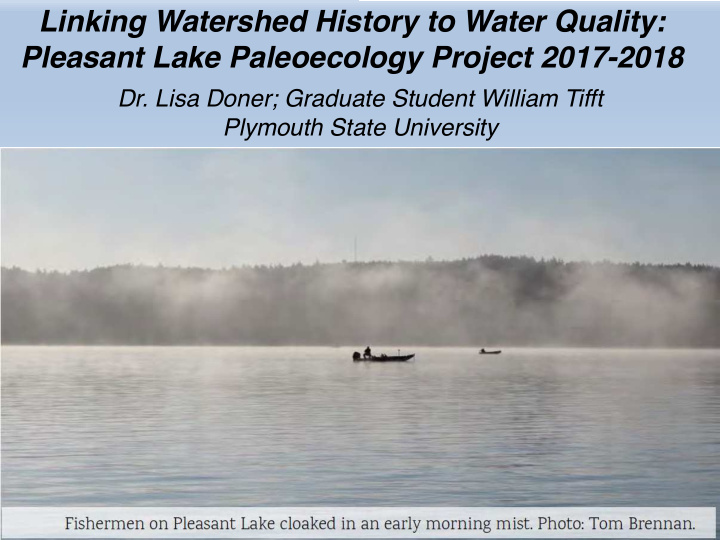



Linking Watershed History to Water Quality: Pleasant Lake Paleoecology Project 2017-2018 Dr. Lisa Doner; Graduate Student William Tifft Plymouth State University
Pleasant Lake Watershed Restoration Plan 2017
Approximate Sediment Core Location x naturally low in oxygen because of lake stratification Sediment environment
Sediment coring concept – All solid material in a watershed eventually ends up at the lowest spot. In lakes, this material is permanently trapped by the basin, so it accumulates. Coring collects these materials in their depositional sequence. Over thousands of years, lakes fill up with sediment, becoming shallower and more organic-rich. Human activity can greatly increase the rate of infilling, by enhancing erosion and organic deposition
Sediment Core Collection in August 2017 Lowering the empty corer tube to the lake bottom Setting out anchors to prevent drift Retrieving the corer (sediment collected inside the tube) Noting location and water depth
Two cores collected: Pleasant Lake 2017-1 and Pleasant Lake 2017-2
gray Both cores have subtle but distinct 10-13 cm changes in sediment color changes occur at about 10-13 cm and 36-40 cm below the core top greenish brown smearing of sediment on the core liner blurs color transition, but remember those depths! 36-40 cm tan
Sampling the core in the lab Subsamples: 1 cm intervals 50 cm-long core = 50 samples
Each 1 cm-thick sample is dried (by freeze-drying) and then split into subsamples for these analyses: • carbon content (loss-on-ignition) - completed • sediment chemistry (ICP-OES) - completed • sediment magnetism - completed • particle-size (laser-based) - pending • sediment age determination ( 210 Pb) - submitted Total number of subsamples analyzed: 50 samples x 5 subsamples = 250 analyses Pleasant Lake 2017-1 has 50 samples at 1 cm intervals Pleasant Lake 2017-1 has 100 samples at 0.5 cm intervals
Key questions asked in the watershed plan: 1. Organic Content – has it changed significantly across the depositional time period? 2. Phosphorus levels – could the sediments be a potential source that could “fertilize” the water with changes in oxygen level? 3. Has the lake’s sediment accumulation rate changed over time?
Organic Carbon Content of Pleasant Lake’s Sediments 26 strong increase in organic levels starting about 10-13 cm (and a decrease between 25 36-45 cm). These values are also affected by changes in mineral inputs to the lake (erosion), but the recent trend is likely true 24 Loss on Ignition (%) 23 Historical baseline 22 21 0 5 10 15 20 25 30 35 40 45 50 Depth (cm)
Phosphorus Content of Pleasant Lake’s Sediments 0.23 No obvious trend but spike 0.22 in recent deposits (one sample) and at core bottom 0.21 Sediment Phosphorus (%) below 40 cm 0.2 0.19 0.18 Historical baseline 0.17 0.16 0.15 0 10 20 30 40 50 Sediment Depth (cm)
Need to know the time interval for each sample to determine the sediment accumulation rate. But we can use indicators of erosion to see if there are changes in the amount of material being transported to the lake basin. Typical indicators are: Sediment particle size (in progress) Sediment Magnetism Carbon to Nitrogen Ratio Sediment Chemistry (soil cations like K, Ca, Mg)
Magnetic Behavior of Pleasant Lake’s Sediment Layers 1.6E-05 1.4E-05 1.2E-05 Magnetic Susceptibility (SI Units) Higher magnetism 1.0E-05 often indicates more land erosion. 8.0E-06 Sharp increases at 6.0E-06 40 cm and 33 cm; 4.0E-06 more decreases above 10 cm 2.0E-06 0.0E+00 0 5 10 15 20 25 30 35 40 45 50 Sediment Depth (cm)
Carbon to Nitrogen Ratio in Pleasant Lake’s Sediments Slightly higher values = more debris from land plants in this interval 11 Carbon to Nitrogen Ratio 10 lower values = more algae starting at 10-13 cm 9 8 0 5 10 15 20 25 30 35 40 45 50 Sediment Depth (cm)
Soil Cations in Pleasant Lake's Sediments K (%) Mg (%) 1.4 0.4 same peak in phosphorus maybe an ”event” like a flood 1.3 0.35 1.2 Historical 1.1 Potassium (%) baseline Magnesium (%) 0.3 1 0.9 0.25 sharp increase above 40 cm; 0.8 more change above 13 cm 0.7 0.2 0.6 0.5 0.15 0 5 10 15 20 25 30 35 40 45 50 Sediment Depth (cm)
Current areas in the watershed with higher potential for soil erosion – both are near the coring location (white dot) Note that as land uses change, so will areas prone to erosion
Heavy Metals in Pleasant Lake Sediments Pb (ppm) Zn (ppm) Cr (ppm) Cu (ppm) 300 60 note this sample stands out again 250 50 200 40 150 30 100 20 33-40 cm is an interval of increased metal loads – this is probably the beginning of 50 10 gasoline and diesel fuel use (ca 1915) 0 0 0 5 10 15 20 25 30 35 40 45 50 Sediment Depth (cm)
Lead 210 Dating Scientific principle: The amount of radioactive lead decreases steadily over time. We can measure that concentration in each sediment samples from the core. At the top of the core, the Pb210 concentration is highest . At the core bottom, it may be zero. We anticipate receiving data From this relationship, sediment that looks somewhat like this age can be determined. (but showing Pleasant Lake’s depositional pattern)
Thank you This work is continuing – William Tifft is using this in his Master’s thesis, looking for storm events like Tropical Storm Irene, Superstorm Sandy, and the 1959 and 1938 hurricanes. Questions – my email: ladoner@Plymouth.edu
Recommend
More recommend